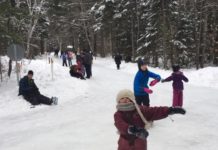By Kari Svenneby
Recent news has been buzzing with advice from healthcare professionals who advocate outdoor play for children. We call it fresh air living and see it as a lifestyle, not just something we add to our children’s list of activities and programs. Fresh air living incorporates unstructured play, outdoor sports, and outdoor learning. Though it has existed for a long time, the concept of outdoor learning is seen as a new teaching approach for all academic disciplines. It engages and motivates learners through first-hand experiences that demonstrate the relevance of the knowledge being taught.
Nearly all adults will tell you that their most positive childhood memories occurred outside. However, when it comes to our own kids, we declare that times have changed, taking the path of least resistance rather than coming up with ways to enrich their lives.
The present trend in North America of beginning formal education at an earlier age, rife with media and technology, seems to push children away from free outdoor activity. Recent studies have shown that unstructured play is the best activity for children. At first glance it seems counterintuitive. If the first five years of a child’s life are the most important in leaning and development, how does unstructured outdoor play foster their ability to become successful students and adults? Researchers, academics, and childhood advocates around the world are beginning to understand and publish the importance of play and nature for children.
Nature Deficit Disorder
Richard Louv postulates in his book Last Child in the Woods: Saving Our Children from Nature Deficit Disorder that the rise in obesity, attention disorders, and depression in children in North America is directly linked to a lack of outdoor experiences. A 2004 University of Illinois study found that children with attention deficit hyperactivity disorder experienced “significant symptom abatement” after spending time outdoors.
Physical skills
According to research in both Europe and North America, using the outdoors as a play arena fosters the greatest growth in children. In outdoor daycares in Scandinavia, children who use nature as their playground have better motor skills, balance, and coordination compared to children using traditional playground equipment. Silken Laumann, Canadian champion for kids’ play and successful Olympic athlete, says sports and unstructured play are bound together. Children need both to grow successfully.
Study showed science scores improved
A California Department of Education study from 2005 showed that sixth-graders improved their science scores by twenty-seven percent after taking week-long outdoor education classes. Several University of Michigan studies have suggested that proximity to nature enhances people’s ability to concentrate.
Fosters creativity
Being outside creates a sense of wonder. The great outdoors fosters creativity for children through pretend play, games, and simply seeing and smelling nature. “Natural spaces and materials stimulate children’s limitless imaginations,” says Robin Moore, advocate for outdoor play and Director of Natural Learning Initiative. “[The outdoors] serves as the medium of inventiveness and creativity observable in almost any group of children playing in a natural setting”. Nature has a calming effect on children, just as it does for us adults. Cornell University environmental psychologists found in a 2003 study that children who spend time in nature are less stressed than children who live in low-nature conditions.
Nature calms children
Nature calms children Nature has a calming effect on children just as it does for us adults. Cornell University environmental psychologists found in a 2003 study, that children who have nature around them are less stressed than children who lived in low-nature conditions.
ADHD
In 2004, a University of Illinois study found that children with attention deficit hyperactivity disorder experienced “significant symptom abatement” after spending time outdoors.
Vitamin D
Recent research has found that many children have vitamin D deficiencies, especially in winter months. Having children spend time outside on a sunny winter day is just as important as giving vitamin D supplements. Spending time outside also helps fight the winter blues and Seasonal Affective Disorder.
Teach children to take care for the environment
David Suzuki says that the best way to teach children to take care for the environment is to spend time in nature. By being a part of nature, children intuitively learn to care about environmental issues.
Reduce you carbon footprint
Spending time outside playing, walking, biking, x–country skiing and tobogganing, doesn’t use carbon-emitting energy. As we rediscover the natural environments that surround us, we discover that we don’t have to travel as much or spending as much time indoors thereby reducing our carbon footprint.
Children are less sick
Children who spend time outside are sick less often than children who spend time inside. In Nordic countries, there has been a consensus for decades that children who attend nature daycares (where they spend time outside in all weather) are healthier than children in traditional daycare settings. According to Professor Ingunn Fjørtoft, Faculty of Arts at Telemark University College in Norway, this can be explained by the simple fact that children spending time indoors have more opportunities to spread viruses both by airborne and contact methods.
Nature exists everywhere
Nature exists everywhere, even in the city. It can be in your backyard, local park, ravine, or even an empty lot in an urban setting. It can be on a farm, by a lake, or by the coast in the wilderness. It is important to use the outdoors in all seasons. We have countless opportunities to vary play scenarios according to the four seasons. Our summer is full of water activities and glorious days at the park or cottage, winter gives us opportunities to play in the snow and ice, and fall and spring have their own special offerings of puddle jumping, mud pies, and falling leaves. The seasons not only present fresh opportunities to play but also teach natural science, language development, and even math without sitting in a room looking at flash cards.








